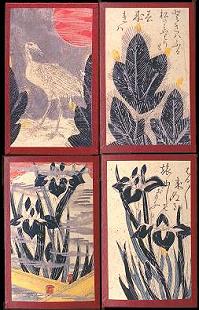
one scoring and one "trash" card,
from Pine (top row) and Iris suits |
This special edition, recently produced by Ôishi, is a replica of an original deck dating back to the Meiji era (1864-1912), that one century earlier had been commissioned to the same manufacturer by Itô Hirofumi (1841-1909), the first Japanese prime minister. He was a lover of figurative art of his own country, and had a particular interest for the typical flower card illustrations. During the 19th century, despite some graphic details were still partly subject to changes, the design of the local cards had gradually reached a certain stability, and its basic elements had become a standard: a crane on the first card of Pine, a nightingale on the same card of Plum, the curtain on Cherry, and so on, including the ones with red and blue ribbons. The edition that Hirofumi had made by Ôishi could be described today as "luxury". The maker kept one copy for himself, and from this specimen, in 1991, a faithful replica was obtained, also called Sôridaijin no Hana-karuta ("prime minister's flower cards"), in honour of the important client. |
A curious twist of fate concerning the premier is that during a state visit in the United States, he became aware that on playing card decks a tax was imposed; up to those days this had only been a Western custom. When he returned home, in order to improve the country's financial situation, which had been seriously affected by the war against Russia (1904-5), he introduced the tax in Japan, as well; but within a few years this caused a dramatic decrease of playing card sales, and several makers even had to close down their workshops! |

the nightingale and the boar,
from Plum and Bush Clover suits |
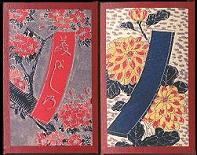
red and blue ribbons |
A first interesting feature of the deck is its size, 5 ´ 8 cm (2 ´ 3¼ inches), larger than the Japanese modern standard. Actually, this was the "old" size that Japanese playing cards used to have in the 1800s, still due to the early attempt of reproducing the decks that had been first brought into the country from Europe (see historical notes); in fact, these cards are only slightly smaller than Western ones. |
Despite being an edition with a special design, the main regional pattern it was modelled upon is the
Echigobana (see
page 4); several details are consistent with the latter, such as the presence of poems in some of the the backgrounds, and particularly the man from the Willow suit, trapped inside his folded umbrella.
Instead a peculiar feature of this edition is the different colour of the backgrounds, which should help the player to tell the scoring subjects (i.e. the ones with animals, ribbons, etc.) from the non-scoring ones ("trash" cards) more easily. The former cards have a gray-silver colour in the background (either applied evenly, or in the shape of clouds, or dots, or raindrops in the suit of Willow, etc.); instead in thrash cards it is white, i.e. non-coloured. Interestingly, in the first card of Eulalia suit ("moon") the background was already red. |
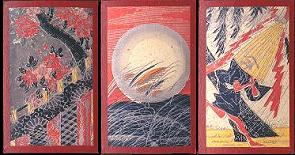
three of the five "light" cards:
the curtain (Cherry), the moon (Eulalia)
and the man with the umbrella (Willow) |

GOLDEN PEONY
this edition is by Windmill
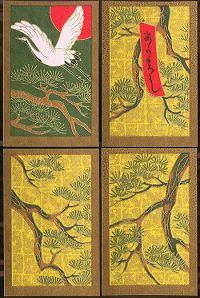
the whole Matsu (pine) family |
The colourful Hanafuda edition by Windmill, named Kin-Botan, "Golden Peony", is a faithful replica of another original deck once belonged to Itô Hirofumi.
The deck is similar in size to the edition previously described (6 ´ 9 cm, or 2¼ ´ 3½ inches), more or less double the modern Japanese cards. Each subject is printed on brown cardstock of "ordinary" thickness, i.e. similar to the one used for Western cards.
Yet featuring the usual Hanafuda subjects, these illustrations are even fancier than the ones belonging to the previous edition.
|
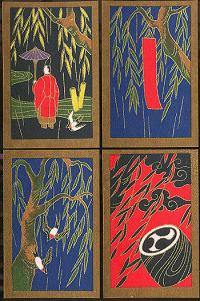
the whole Yanagi (willow) family |
|
The scoring cards (hikari, tane, tan) are printed in very
bright colours, while the kasu cards are yellow, with a particular background texture;
only the kasu card of Yanagi (willow) maintains its traditional red colour.
These cards are printed following a special technique called Kyôto yuuzen, which is
the one traditionally used in Kyoto for printing textures on kimono garments.
In most cards, the main subject is enriched with details in gold paint, giving reason for
the name of the deck, which is featured on the extra card.
|
below: tane cards from
Hagi (bush clover) and Momiji (maple)
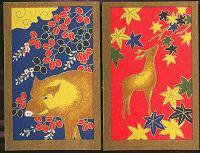
|
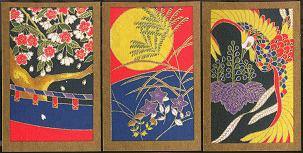 |
left: Curtain, Moon and Phoenix, respectively
from Sakura (cherry), Susuki (Eulalia)
and Kiri (paulownia) families;
right: the extra card, with the deck's name
|
 |
 OR
OR 
DRAGON-TIGER or SEVEN-SEVEN FLOWER CARDS
this edition is by Matsui Tengudô (Japan)
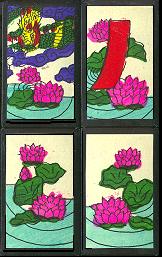
the full suit of Hasu (lotus) |
Hanafuda games are traditionally played
between two opponents. In year 2000, manufacturer Matsui Tengudô issued a
four-player version, named Ryuu-Ko
("Dragon-Tiger") after the tane subjects of
two extra suits found in the deck. The game, though, is also
referred to as Nana-nana-bana
("seven-seven flower cards"), which mimics hachi-hachi
("eight-eight"), the traditional game played with standard
Hanafuda decks.
Despite being a novelty, all subjects follows quite closely the
flower card classic design, including the two suits
created for this purpose.
|
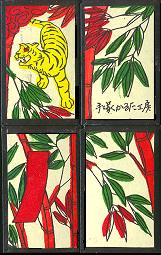
the full suit of Sasa (bamboo) |
The extra suits are Hasu (lotus),
also described as "heaven month", whose tane card features the dragon, and
Sasa or Take (bamboo), also described
as "earth month", whose
tane card features the tiger. Both suits also have a red tan (ribbon) card.
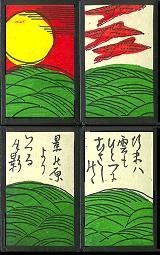
the full suit of Susuki (eulalia):
note the tanka poem on the kasu cards |
The other suits and subjects of the deck are the standard ones (see picture below), although
as a reminiscence of the early Meiji period editions (19th century),
verses of tanka poems are featured on the kasu cards of
Pine, Plum, Wisteria, Iris, Eulalia and Maple families, a detail
also found in the Echigobana regional pattern
(see page 3).
All together, the cards of the "Dragon-Tiger" deck are 56, plus a blank spare card.
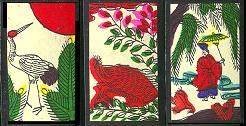
hikari and tane cards from the "Dragon-Tiger" edition |

SHIKISHIMA FLOWER CARDS
this edition is produced by Nintendo and released by Okuno Karuta (Japan)
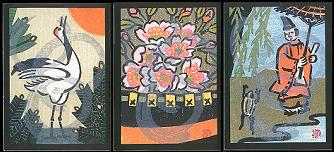
three "light" cards: the crane,
the curtain and the man with the umbrella |
Takumi Itô is a contemporary artist, active since the mid 1940s.
In 2004 she* created a series of 48 woodblock prints for the Hanafuda subjects, which she entitled after an old name that the Japanese used to refer to their own homeland, Shikishima, roughly meaning "the lovely island". In fact, the pretty illustrations underline the environmental details, making them more eye-catching than in standard editions, yet without turning them glamorous, thanks to the choice of sober colours, and to the naive finish of the woodblock technique. |
The size of these cards is a bit larger than the usual editions, and the pictures are printed directly on the cardstock.
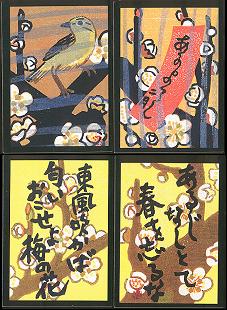
the full suit of Ume (plum) |
The traditional Hanafuda pattern this edition was mainly inspired by is the Echigobana (see page 4), whose subjects are characterized by overprints, which in the Shikishima Hanakaruta are silver/greyish in colour, rather faint, and by tanka poems featured on some of the kasu ("trash", non-scoring) cards. |
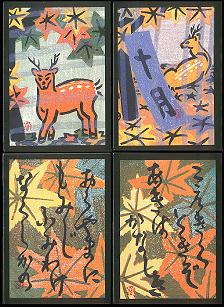
the full suit of Momiji (maple) |
Instead another feature, likely borrowed from the Awabana pattern (see again page 4), is the presence of the month's name spelt on each ribbon.
This deck comes with two extra cards (picture on the right), one with a small oni or demon, the other featuring a further ribbon, whose text is the name of the firm that released the Shikishima edition, Okuno Karuta. |
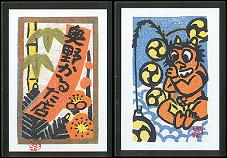
the two extra cards |
HANAPUA
this edition is produced by Starlei Publishing (Hong Kong) and released by Puna Enterprises (Hawaii)
Hanapua is a fancy edition whose subtitle Hawaii Flower Card Game suggests having been devised with the purpose of reviving the interest of Hawaiian players for Hanafuda. On the Pacific island live the descendants of many Japanese post-WW II expatriates, who gradually lost interest in the traditional game. Sets printed on regular cardstock, with Japanese flower names translated into English, were manufactured for some time, but Hanafuda games kept losing ground to Western ones all the same. |

tane and tan from the suit of Palms |

tane and kasu from the suit of Pineapple |
This Hanapua edition goes back to the roots, as it is printed on traditionally sized cards, but the twelve suits have been completely changed (see table), choosing not only flowers, but also other local features (e.g. petroglyphs). The design of each subject was adapted to the new suits, without a strict relation to the traditional ones, yet maintaining the classic graphic style of Hanafuda illustrations. |
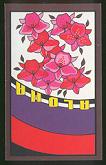
tane from the suit of Orchid |
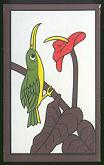
tane from Bird of Paradise |
These are the twelve alternative suits in the Hanapua deck:
| Bamboo |
Hibiscus |
| Vanna |
Bird of Paradise |
|---|
| Plumeria |
Pineapple |
|---|
| Monstera |
Taro |
|---|
| Orchid |
Palm Tree |
|---|
| Anthurium |
Petroglyph |
|---|
|
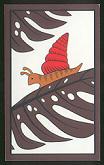
tane from Monstera |
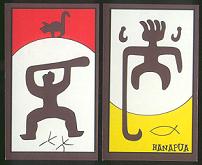
tane and kasu from Petroglyph |
Among the noticeable features is the well-known greeting ALOHA, spelt on the red vertical ribbons and - upside down - along the curtain card. Instead the word HANAPUA appears on one of the 'trash cards' of the curious Petroglyph suit. |
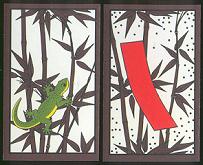
tane and tan from Bamboo |
other pages in this gallery
OTHER GALLERIES






















or back to

HISTORICAL
NOTES
|

MULTI-LANGUAGE
GLOSSARY |

THE FOOL &
THE JOKER |

INDEX
TABLE |

REGIONAL
GAMES |

PLAYING CARD
LINKS |